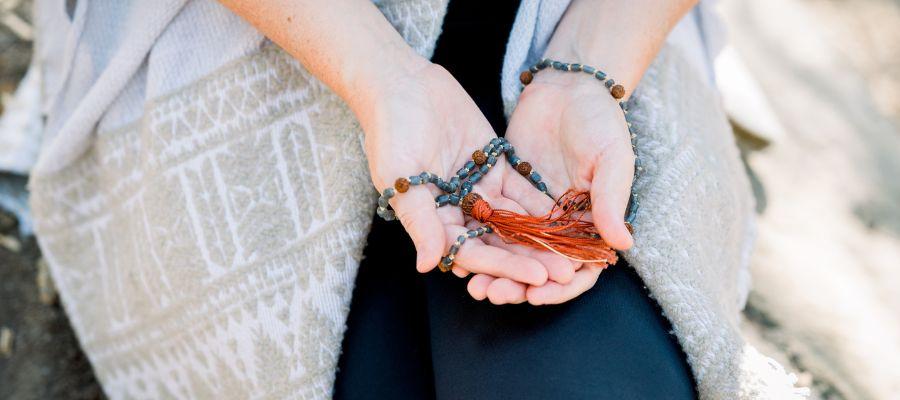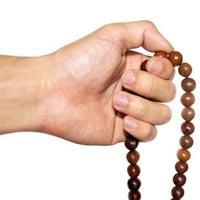
Buddhist prayer beads, traditionally called Malas, were first developed as a religious tool on the Indian continent.

A Japa mala or mala (Sanskrit word meaning garland) is a set of beads commonly used by Hindus and Buddhists. Malas are used for keeping count while reciting, chanting, or mentally repeating a mantra or the name or names of a deity. This practice is known in Sanskrit as japa.
The English word rosary (a western term for prayer beads) comes from a Roman miscommunication. When the Roman explorers came to India and encountered the mala, they heard jap mala, and jap for the Romans meant rose. The word rosary eventually evolved from that translation as Romans carried the prayer bead concept back to the western world. Click this link to see Mala Beads we have in stock.
The use of 108 beads has come about from the following formula:
6 x 3 x 2 x 3 = 108
6 Senses of a Human Being:
Sight, sound, smell, taste, touch, thought.
3 Times:
Past, present, future.
2 Conditions of Heart, Mind or Intention:
Pure or impure.
3 Disturbing Emotional States or “kleshia”:
Like, dislike, indifference.
A Buddhist mala comprises 108 beads, excluding marker beads, decorative beads, or a guru bead, each representing impurities and flaws that individuals aim to overcome. The 109th bead, referred to as the bindu, stupa, or guru bead, marks a significant point. Counting always commences with the bead next to the sumeru. In the Hindu Vedic tradition, when performing multiple repetitions with a mala, one changes directions upon reaching the sumeru instead of crossing it.
For a 21-bead Mala bracelet, complete five full rotations around the bead mala to accomplish a full meditative cycle of 100 mantras, mirroring the number of mantras achieved with a full-sized mala necklace.
What is their purpose?
The purpose of the Mala from a Buddhist, Hindu, Moslem or Christian point of view is for counting of sacred mantra (prayers) during a period of recitation. For example, you may recite, Om Mani Padme Hum, Hail Mary, full of Grace…, or Om Tare Tam Soha and keep a count of each mantra by moving your fingers over each bead. And, of course, you can use the Mala for any sacred prayer from any spiritual or religious tradition.
Care of Mala Beads
Do not lay/place them on the ground or floor. If you drop it, clean it off, and place it on top of your head as you say Om, Ah, Hung, OR some other type of prayer of blessing from your native tradition. Touching someone with it as an act of blessing or healing can be appropriate, if they allow you or ask you to. Having your Mala blessed by a holy person, respected practitioner, priest, lama or Guru is also beneficial.
Do They Have Mystical Powers?

The Mala itself does not have any mysterious power. The belief that the Mala is a source of power is a misunderstanding and reflects a western tendency to place the source of spiritual power, virtue and goodness outside of ourselves. It is our own divine connection to deity, be it God, Goddess or Buddhas, that produces the power in the Mala beads. When we strengthen our connections in prayer or meditation, then the power of the Mala is activated.
If you allow your mind to be gently reminded of the importance of keeping a positive state of mind, wishing good to others and opening yourself up to auspicious and blessed states of being, then the Mala is an aid in drawing the mind closer to the celestial and divine sources from within you and around you. It is a tool to bridge your mind to Spirit or deity.
